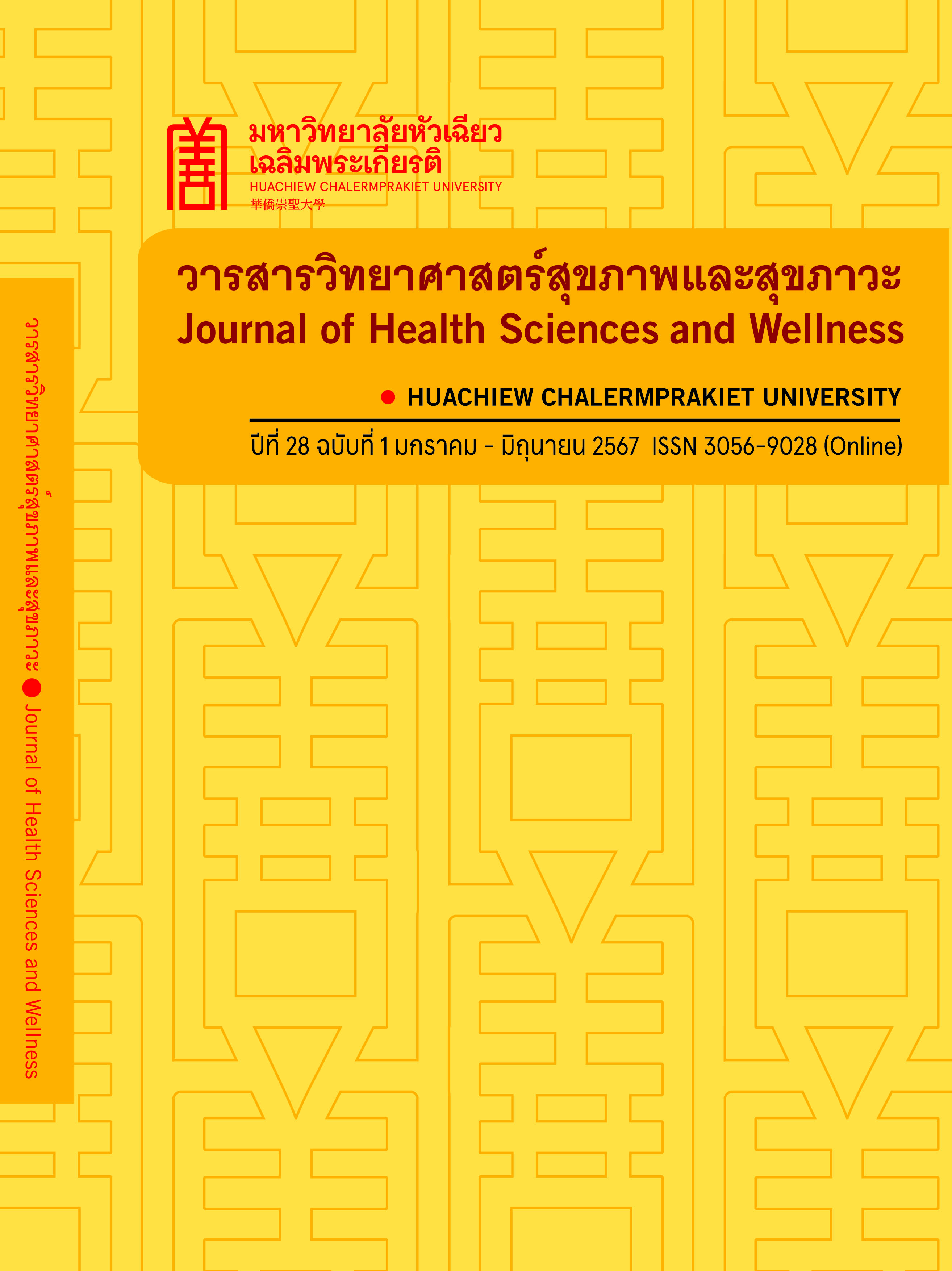The Effect of a Breastfeeding Support Program with Line Application on Breastfeeding Behaviors and the Rate of Exclusive Breastfeeding at 1 Month in Adolescent Mothers
Keywords:
adolescent mothers, exclusive breastfeeding, breastfeeding behaviors, applicationAbstract
This quasi-experimental research aimed to examine the effect of a breastfeeding supportprogram with Line application on breastfeeding behaviors and the rate of exclusive breastfeeding at one month in adolescent mothers. The sample consisted of 46 mothers aged 10 to 19-years old who stayed in the postpartum ward at a tertiary hospital in Samut Prakan province. The experimental
group (n=23) received the breastfeeding support program plus routine postpartum care, while the control group (n=23) received only routine postpartum care. Data were collected using the demographic characteristics interview, B-R-E-A-S-T-Feed observation form, and the Infant's Feeding interview form. The study used descriptive statistics, the Chi-square test, the Fisher Exact test, the Independent T-test, the Paired T-test, the Wilcoxon Signed-Rank test, and the Z-test to analyze data.
The results showed that the mean score of breastfeeding behavior in the experimental group was statistically significantly higher than that of the control group at .05 (t = 2.12). The exclusive
breastfeeding rate of the experimental group was statistically significantly higher than that of the control group (Z = 2.88, p = .004). Some suggestions from that study are for nurse midwives to follow up on breastfeeding problems after discharge and give advice according to the problems of the mothers using an application promoting the success of exclusive breastfeeding.
Downloads
References
Ministry of Public Health. Benefits of breastfeeding [internet]. 2018 [cited 2023 Apr 30]. Available from: https://multimedia.anamai.moph.go.th/help-knowledgs/benefits-of-breastfeeding (in Thai)
UNICEF. Breastfeeding: the best possible start in life [internet]. 2022 [cited 2023 Apr 10]. Available from: https://www.unicef.org/india/stories/breastfeeding-best-possible-start-life
UNICEF. Infant and young child feeding data [internet]. 2021 [cited 2023 Apr 10]. Available from: https://data.unicef.org/topic/nutrition/infant-and-young-child-feeding
The Thailand National Statistical Office, UNICEF Thailand. Exclusive breastfeeding rate [internet]. 2023 [cited 2023 Jul 23]. Available from:https://www.unicef.org/thailand/th/press-releases (in Thai)
The Thailand National Statistical Office, National Health Security Office, UNICEF Thailand. Thailand: multiple indicator cluster survey 2015-2016 [internet]. 2016 [cited 2023 Jul 23]. Available from: https://www.unicef.org/thailand/media/176/file/Key%20Findings%20from%20 Thailand%20Multiple%20ndicator920cluster920Survey%202015-2016%20 (in Thai)
Puapornpong P, Raungrongmorakot K, Manolerdtewan W, Ketsuwan S, Wongin S, Satirapoj B. Teenage pregnancy and exclusive breastfeeding rates. J Med Assoc Thai. 2014; 97(9):893-8. (in Thai)
Ministry of Public Health. Indicators at the ministry level 2017 [internet]. 2017 [cited 2022 Aug 1]. Available from: http://www.anamai.moph.go.wh/download/download/102557/ strategic_plan/1/3 (in Thai)
Ngamnil N, Kaewkiattikun K. Prevalence of exclusive breastfeeding among adolescent mothers in Bangkok. Thai J Obstet Gyna col. 2019;27(2):79-87. (in Thai)
World Health Organization. Statistics on breastfeeding 2017 [internet]. 2017 [cited 2020 May 8]. Available from: https://www.socialstyrelsen.se/globalassets/sharepoint-dokument/artikelkatalog/statistik
Phahuwatanakorn W, Soothampitag M. Comparison of breastfeeding problems during early postpartum between mothers with exclusive breastfeeding and mothers with non-exclusive breastfeeding at 1 month. Nurs Sci J Thai. 2013;31(4):57-66. (in Thai)
Wirakul, C. Factor affecting exclusive breast feeding at least 6 months in Naresuan university hospital. J Educ Innovation Res. 2014;12(1):746-57. (in Thai)
Chuprapan P, Thiangthum W, Pichayapinyo P. Factors influencing exclusive breastfeeding withina 6 months'period among mothers in south central region of Thailand [internet]. 2014 [cited 2020 May 08]. Available from: https://gsbooks.gs.kku.ac.th/57/grc15 (in Thai)
Karacam Z, Saglik M. Breastfeeding problems and interventions performed on problems: systematic review based on studies made in Turkey. Turk Arch Ped/Turk Ped Ars. 2018;53(3):134.
Supasiripenpong K. Factors effecting continuing breastfeeding of adolescent mothers at suratthani hospital. Region 11 Med J. 201832(1):853-62. (in Thai)
Plaichum S, Ongswas T, Somboon L. Factors related to breastfeeding duration among adolescent mothers. Nurs J. 2012;39(2):79-87. (in Thai)
Khoonphet C, Kala S. The experience of breastfeeding intention among adolescent mothers. Princess Naradhiwas University J. 2019;11(2):1-11. (in Thai)
Gao L, Larsson M, Luo Y. Internet use by chinese women seeking pregnancy-related information. Midwifery. 2013;29(7):730-5.
Lagan M, Sinclair M, George W. Internet use in pregnancy informs women's decision making: a web-based survey. Birth. 2010;37(2):106-15.
Celik R, Toruner K. The effect of technology-based breastfeeding approach on adolescent mothers' breastfeeding situation. Int J Obstet Gyna col. 2017;4(1):1-6.
Lau Y, Htun P, Tam S, Klainin P. Efficacy of e-technologies in improving breastfeeding outcomes among perinatal women: a meta-analysis. Matern Child Nutr. 2016;12(3):381-401.
Srijaiwong S, Khiaolueang D, Khiaolueang N, Suwanarod P, Muenglaeng S. Health system development for unintended adolescent pregnancy. Boromarajonani College of Nursing, Uttaradit J. 2021;13(1):14-29. (in Thai)
Fisher A, Fisher D, Harman J. The information-motivation-behavioral skills model: a general social psychological approach to understanding and promoting health behavior. Soc Psycho Health. 2003:22(1):82-106.
Glass V. Primary, secondary and meta-analysis of research. Educ Res. 1976;5(10):3-8.
Khakhong S, Nirattharadorn M. The effects of promoting self-efficacy program on breast feeding behavior among adolescent mothers in community. J Public Health. 2017;47(1):31-43. (in Thai)
Cohen S, Williamson G. Perceived stress in a probability sample of the United States. Soc Psycho Health. 1998;5(1):31-67.
Sutthitham P, Phichian Sunthon C. Textbook of clinical research. Bangkok: Amarin Printing; 2018. P.185. (in Thai)
Hangchaowanich Y. Breastfeeding in the first hours after birth. In: Muttamara S, Chusilp K, Suthutvoravut U, Sangtawesin V, Hangchaowanich Y, editors. Breastfeeding. 2nd ed. Bangkok:Aiyara Publiching. 2012. P.55-62. (in Thai)
Wongphinit U, Sinsuksai N, Yusamran C. Personal factors, social support and effective suckling at discharge in predicting exclusive breastfeeding at one month among first-time mothers. J Royal Thai Army Nurs. 2016;17(1):88-95. (in Thai)
Prasertwit P. The effects of formal education program for breastfeeding on knowledge, perceived self-efficacy and health behavior on breastfeeding of postpartum mothers at postpartum ward, Udonthani hospital. Udonthani Hospital Med J. 2018;26(3):185-98. (in Thai)
Paibunbanphot N, Anusorntheerakun S. Effects of breastfeeding promotion program on knowledge, attitude, and breastfeeding skills among postpartum mothers. J Nurs Sci Health. 2015;38(1):41-52. (in Thai)
Mekkamol K. Breastfeeding promotion: community practice guideline. The Southern College Network J Nurs Public Health. 2018;5(3):274-86. (in Thai)
Downloads
Published
How to Cite
Issue
Section
License
Copyright (c) 2024 Journal of Health Sciences and Wellness

This work is licensed under a Creative Commons Attribution-NonCommercial-NoDerivatives 4.0 International License.
บทความที่ได้รับการตีพิมพ์เป็นลิขสิทธิ์ของวารสารวิทยาศาสตร์สุขภาพและสุขภาวะ
ข้อความที่ปรากฏในบทความแต่ละเรื่องในวารสารวิชาการเล่มนี้เป็นความคิดเห็นส่วนตัวของผู้เขียนแต่ละท่านไม่เกี่ยวข้องกับมหาวิทยาลัยหัวเฉียวเฉลิมพระเกียรติ และคณาจารย์ท่านอื่นๆในมหาวิทยาลัยฯ แต่อย่างใด ความรับผิดชอบองค์ประกอบทั้งหมดของบทความแต่ละเรื่องเป็นของผู้เขียนแต่ละท่าน หากมีความผิดพลาดใดๆ ผู้เขียนแต่ละท่านจะรับผิดชอบบทความของตนเองแต่ผู้เดียว




